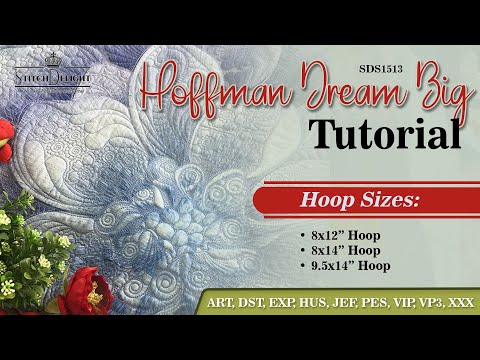What needles are most used for machine embroidery and why, and what other types of needles should one get :
When it comes to machine embroidery, the choice of needles depends on the specific embroidery project and the type of fabric you are working with. Here are some commonly used machine embroidery needles and their purposes:
-
Sharp Needles (also known as Universal Needles): These are the most common and versatile needles used for machine embroidery. They have a sharp point and work well with woven fabrics, such as cotton and linen. Universal needles come in various sizes, and the appropriate size depends on the weight of your fabric.
-
Ballpoint Needles: These needles have a rounded tip instead of a sharp one. They are designed for use with knit and stretch fabrics like jersey or spandex. The rounded tip helps the needle slide between the fabric's fibers without causing damage or breaking the threads.
-
Metallic Needles: Metallic needles are specifically designed for working with metallic threads. They have a larger eye and a larger groove to accommodate the thicker metallic thread, reducing the chance of thread breakage or shredding.
-
Embroidery Needles: Embroidery needles are specifically designed for machine embroidery. They have a larger eye and a deeper groove to protect delicate embroidery threads, such as rayon or polyester. The larger eye makes it easier for the thread to pass through smoothly, reducing friction and potential thread damage.
-
Topstitch Needles: Topstitch needles have an extra-large eye and a large groove, making them suitable for decorative stitching, appliqué work, and using heavier threads. They are ideal for creating prominent and visible stitches.
This is just a overview of needles, BUT what do we really need when we do embroidery, does it work the same as with normal sewing ? From personal experience, the very short answer is NO.
n machine embroidery, the most commonly used needle size is 75/11 sharp needles, which are suitable for approximately 99% of embroidery projects. These needles possess a balanced thickness that allows them to glide seamlessly through various fabric thicknesses, without bending, as long as the design is not excessively dense. By "overly dense," I mean a design that is extremely tightly packed, akin to being bulletproof.
But lets look at the different needle points and point out some differences as we do change to something different to help with problem solving. Say your thread keeps fraying ? Or you keep on bending or breaking needles, lets see how we start to eliminate issues to get to the bottom of the problem.

The 3 basic needle points looks like these above, you get your very sharp pointed needle, a universal and then the ballpoint.
- In general we use the sharp point needles, they are suited for most fabric types such as cotton, linen and even satin and works well with standard and medium-weight fabrics.
- Universal needles are versatile as well and can work with the above as well as woven and knit fabrics, silk and jersey. This is my go to needle for almost all my projects I do, its a happy medium and works well with ANY fabric.
- Ball point needles have a rounded tip, and works very well with knit fabric, jersey and stretch fabrics.
Why do I recommend universal needles? Well, considering that I frequently engage in embroidery projects involving diverse fabrics, sometimes even combining different fabric types within a single project, I prefer to avoid the hassle of changing needles at every step. Universal needles provide the flexibility to work with any fabric I choose, regardless of its type. However, you may wonder why I still keep other types of needles in stock. The reason is that with the wide array of fabric varieties out there, I may encounter a particularly challenging fabric that tests my patience. In such cases, I tend to opt for sharp needles when dealing with tightly woven fabrics or ballpoint needles when faced with highly stretchable or loosely woven fabrics. Having a range of needle options allows me to navigate through the complexities of different fabric types effectively.

You might wonder which brand I prefer. Well, considering that I work with both home embroidery machines and multi-needle machines, I keep two different types of needles in stock. For my single-needle machine, I prefer Schmetz needles, while for my multi-needle machine, I opt for GROZ-Beckert needles. The distinction lies in the needle design: the single-needle machines utilize needles with a flat surface on one side, while the multi-needle machines require round shaft needles.
How frequently do I change needles? Well, according to my machine technician, it is advised to change needles after almost every design. However, with nearly 25 years of experience in the industry, I have learned to change needles when necessary. If a design becomes challenging, causing issues such as loopy threads, fraying, or frequent thread breakage, my first instinct is to change the needle. Over time, the needle point can become blunt and may not work well with the specific fabric I am using. While it might still function adequately on fabrics like scuba fabric, it may struggle with fabrics like linen.
Additionally, the eye of the needle can wear out, leading to thread cutting or fraying intermittently. Thus, I have become attuned to the signs indicating when it is time to change the needle for optimal embroidery results. And before changing a needle, make sure its clean and not perhaps just gunked up with 505 Spray (Fabric spray adhesive).
Storage for needles is easy, I have shelve full of small drawers where I store my pins, needles and such

These drawers can be stacked as you wish, making them so versatile - interested, then take a look HERE
I used my trusty Niimbot Label printer, to print labels for each drawer, so I can easily find which drawer has needles inside. This little printer uses no ink, it uses thermal labels, you can purchase easily and prints using heat from your cellphone, a must have if you want to get organized in a hurry.
In the upcoming series of blog posts, I will be sharing fascinating discoveries related to fabric markers, rotary cutters, pins, clips, and more. So, stay tuned! I thoroughly enjoy exploring different stores in search of intriguing notions that enhance our hobby and help us work more efficiently. It never ceases to amaze me how inventors continuously come up with innovative tools to simplify our lives. Interestingly, many of these inventions originate from ordinary individuals like you and me, who find creative solutions to streamline tasks we prefer not to do the long way. We all possess an inventive spirit at some point, contributing to the development of useful tools and techniques in our shared passion.
No idea is too silly, for within the whimsy lies the spark of genius. When ordinary people embrace their creativity, the extraordinary takes flight.











6 commentaires
Thelma
Thank you for this wonderful information! Never to old to learn!
Susan Tamani
Thanks for the info on the needles, quite informative.
Susan Bierly
Thank you for the easy-to-understand information. Blogs help to keep current with quickly changing notions and procedures to achieve professional results. Love the “cliffhanger” for future info.
Sharon Katona
I am always so interested in what everyone has to say about what needles to use. And everyone has their go to needles. I only use embroidery needles in my single needle machine. My dealer told us only to use 90/14 because of the larger eye. They have found people using smaller needles tend to break the automatic threader. I solved the larger eye problem with going to the embroidery needle and use 75/11 almost exclusively.
Love your blog. Thank you for sharing your valuable experience.
Linda Eiden
Thank you. I’m 67 and have sewn and embroidered my whole life and I learned something.
Lorraine Vincent
I am enjoying all the Blog Posts. Have learnt so much from them especially about
Stablizers. Thank you so much and for the 50% sale.